Yunpeng Liu
Towards Seamless Borders: A Method for Mitigating Inconsistencies in Image Inpainting and Outpainting
Jun 14, 2025Abstract:Image inpainting is the task of reconstructing missing or damaged parts of an image in a way that seamlessly blends with the surrounding content. With the advent of advanced generative models, especially diffusion models and generative adversarial networks, inpainting has achieved remarkable improvements in visual quality and coherence. However, achieving seamless continuity remains a significant challenge. In this work, we propose two novel methods to address discrepancy issues in diffusion-based inpainting models. First, we introduce a modified Variational Autoencoder that corrects color imbalances, ensuring that the final inpainted results are free of color mismatches. Second, we propose a two-step training strategy that improves the blending of generated and existing image content during the diffusion process. Through extensive experiments, we demonstrate that our methods effectively reduce discontinuity and produce high-quality inpainting results that are coherent and visually appealing.
SelaVPR++: Towards Seamless Adaptation of Foundation Models for Efficient Place Recognition
Feb 23, 2025Abstract:Recent studies show that the visual place recognition (VPR) method using pre-trained visual foundation models can achieve promising performance. In our previous work, we propose a novel method to realize seamless adaptation of foundation models to VPR (SelaVPR). This method can produce both global and local features that focus on discriminative landmarks to recognize places for two-stage VPR by a parameter-efficient adaptation approach. Although SelaVPR has achieved competitive results, we argue that the previous adaptation is inefficient in training time and GPU memory usage, and the re-ranking paradigm is also costly in retrieval latency and storage usage. In pursuit of higher efficiency and better performance, we propose an extension of the SelaVPR, called SelaVPR++. Concretely, we first design a parameter-, time-, and memory-efficient adaptation method that uses lightweight multi-scale convolution (MultiConv) adapters to refine intermediate features from the frozen foundation backbone. This adaptation method does not back-propagate gradients through the backbone during training, and the MultiConv adapter facilitates feature interactions along the spatial axes and introduces proper local priors, thus achieving higher efficiency and better performance. Moreover, we propose an innovative re-ranking paradigm for more efficient VPR. Instead of relying on local features for re-ranking, which incurs huge overhead in latency and storage, we employ compact binary features for initial retrieval and robust floating-point (global) features for re-ranking. To obtain such binary features, we propose a similarity-constrained deep hashing method, which can be easily integrated into the VPR pipeline. Finally, we improve our training strategy and unify the training protocol of several common training datasets to merge them for better training of VPR models. Extensive experiments show that ......
Rolling Ahead Diffusion for Traffic Scene Simulation
Feb 13, 2025



Abstract:Realistic driving simulation requires that NPCs not only mimic natural driving behaviors but also react to the behavior of other simulated agents. Recent developments in diffusion-based scenario generation focus on creating diverse and realistic traffic scenarios by jointly modelling the motion of all the agents in the scene. However, these traffic scenarios do not react when the motion of agents deviates from their modelled trajectories. For example, the ego-agent can be controlled by a stand along motion planner. To produce reactive scenarios with joint scenario models, the model must regenerate the scenario at each timestep based on new observations in a Model Predictive Control (MPC) fashion. Although reactive, this method is time-consuming, as one complete possible future for all NPCs is generated per simulation step. Alternatively, one can utilize an autoregressive model (AR) to predict only the immediate next-step future for all NPCs. Although faster, this method lacks the capability for advanced planning. We present a rolling diffusion based traffic scene generation model which mixes the benefits of both methods by predicting the next step future and simultaneously predicting partially noised further future steps at the same time. We show that such model is efficient compared to diffusion model based AR, achieving a beneficial compromise between reactivity and computational efficiency.
Why and How: Knowledge-Guided Learning for Cross-Spectral Image Patch Matching
Dec 15, 2024



Abstract:Recently, cross-spectral image patch matching based on feature relation learning has attracted extensive attention. However, performance bottleneck problems have gradually emerged in existing methods. To address this challenge, we make the first attempt to explore a stable and efficient bridge between descriptor learning and metric learning, and construct a knowledge-guided learning network (KGL-Net), which achieves amazing performance improvements while abandoning complex network structures. Specifically, we find that there is feature extraction consistency between metric learning based on feature difference learning and descriptor learning based on Euclidean distance. This provides the foundation for bridge building. To ensure the stability and efficiency of the constructed bridge, on the one hand, we conduct an in-depth exploration of 20 combined network architectures. On the other hand, a feature-guided loss is constructed to achieve mutual guidance of features. In addition, unlike existing methods, we consider that the feature mapping ability of the metric branch should receive more attention. Therefore, a hard negative sample mining for metric learning (HNSM-M) strategy is constructed. To the best of our knowledge, this is the first time that hard negative sample mining for metric networks has been implemented and brings significant performance gains. Extensive experimental results show that our KGL-Net achieves SOTA performance in three different cross-spectral image patch matching scenarios. Our code are available at https://github.com/YuChuang1205/KGL-Net.
From Easy to Hard: Progressive Active Learning Framework for Infrared Small Target Detection with Single Point Supervision
Dec 15, 2024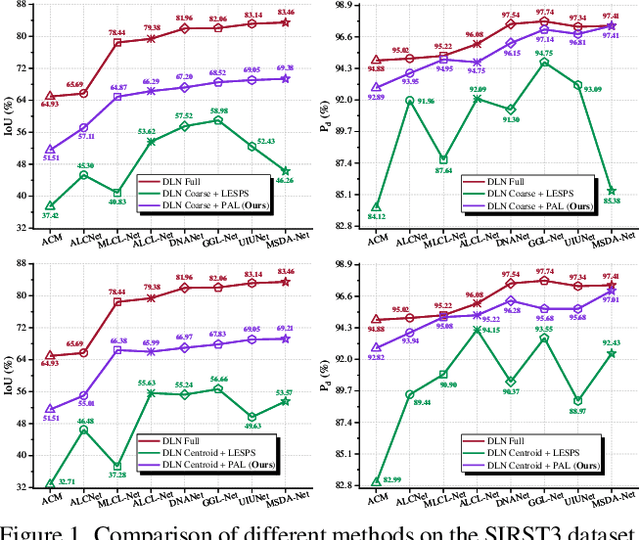
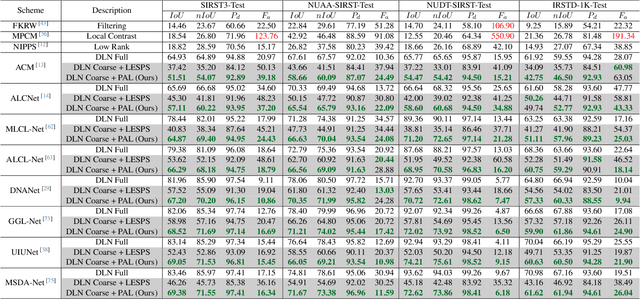
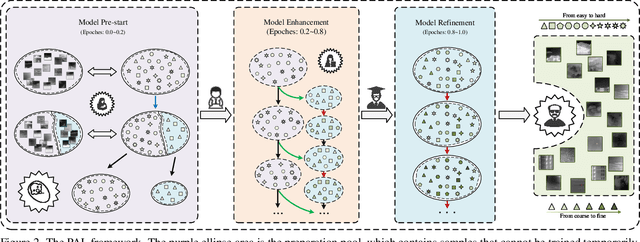
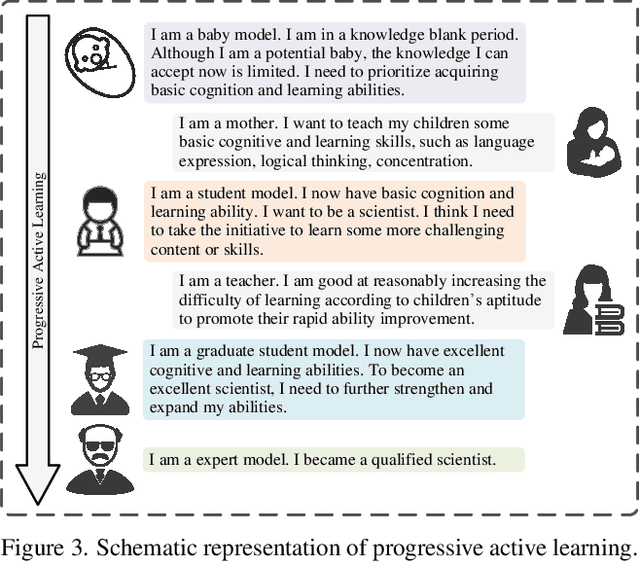
Abstract:Recently, single-frame infrared small target (SIRST) detection with single point supervision has drawn wide-spread attention. However, the latest label evolution with single point supervision (LESPS) framework suffers from instability, excessive label evolution, and difficulty in exerting embedded network performance. Therefore, we construct a Progressive Active Learning (PAL) framework. Specifically, inspired by organisms gradually adapting to their environment and continuously accumulating knowledge, we propose an innovative progressive active learning idea, which emphasizes that the network progressively and actively recognizes and learns more hard samples to achieve continuous performance enhancement. Based on this, on the one hand, we propose a model pre-start concept, which focuses on selecting a portion of easy samples and can help models have basic task-specific learning capabilities. On the other hand, we propose a refined dual-update strategy, which can promote reasonable learning of harder samples and continuous refinement of pseudo-labels. In addition, to alleviate the risk of excessive label evolution, a decay factor is reasonably introduced, which helps to achieve a dynamic balance between the expansion and contraction of target annotations. Extensive experiments show that convolutional neural networks (CNNs) equipped with our PAL framework have achieved state-of-the-art (SOTA) results on multiple public datasets. Furthermore, our PAL framework can build a efficient and stable bridge between full supervision and point supervision tasks. Our code are available at https://github.com/YuChuang1205/PAL.
See Further When Clear: Curriculum Consistency Model
Dec 09, 2024



Abstract:Significant advances have been made in the sampling efficiency of diffusion models and flow matching models, driven by Consistency Distillation (CD), which trains a student model to mimic the output of a teacher model at a later timestep. However, we found that the learning complexity of the student model varies significantly across different timesteps, leading to suboptimal performance in CD.To address this issue, we propose the Curriculum Consistency Model (CCM), which stabilizes and balances the learning complexity across timesteps. Specifically, we regard the distillation process at each timestep as a curriculum and introduce a metric based on Peak Signal-to-Noise Ratio (PSNR) to quantify the learning complexity of this curriculum, then ensure that the curriculum maintains consistent learning complexity across different timesteps by having the teacher model iterate more steps when the noise intensity is low. Our method achieves competitive single-step sampling Fr\'echet Inception Distance (FID) scores of 1.64 on CIFAR-10 and 2.18 on ImageNet 64x64.Moreover, we have extended our method to large-scale text-to-image models and confirmed that it generalizes well to both diffusion models (Stable Diffusion XL) and flow matching models (Stable Diffusion 3). The generated samples demonstrate improved image-text alignment and semantic structure, since CCM enlarges the distillation step at large timesteps and reduces the accumulated error.
EDTformer: An Efficient Decoder Transformer for Visual Place Recognition
Dec 01, 2024



Abstract:Visual place recognition (VPR) aims to determine the general geographical location of a query image by retrieving visually similar images from a large geo-tagged database. To obtain a global representation for each place image, most approaches typically focus on the aggregation of deep features extracted from a backbone through using current prominent architectures (e.g., CNNs, MLPs, pooling layer and transformer encoder), giving little attention to the transformer decoder. However, we argue that its strong capability in capturing contextual dependencies and generating accurate features holds considerable potential for the VPR task. To this end, we propose an Efficient Decoder Transformer (EDTformer) for feature aggregation, which consists of several stacked simplified decoder blocks followed by two linear layers to directly generate robust and discriminative global representations for VPR. Specifically, we do this by formulating deep features as the keys and values, as well as a set of independent learnable parameters as the queries. EDTformer can fully utilize the contextual information within deep features, then gradually decode and aggregate the effective features into the learnable queries to form the final global representations. Moreover, to provide powerful deep features for EDTformer and further facilitate the robustness, we use the foundation model DINOv2 as the backbone and propose a Low-Rank Parallel Adaptation (LoPA) method to enhance it, which can refine the intermediate features of the backbone progressively in a memory- and parameter-efficient way. As a result, our method not only outperforms single-stage VPR methods on multiple benchmark datasets, but also outperforms two-stage VPR methods which add a re-ranking with considerable cost. Code will be available at https://github.com/Tong-Jin01/EDTformer.
Towards Fine-Grained Webpage Fingerprinting at Scale
Sep 06, 2024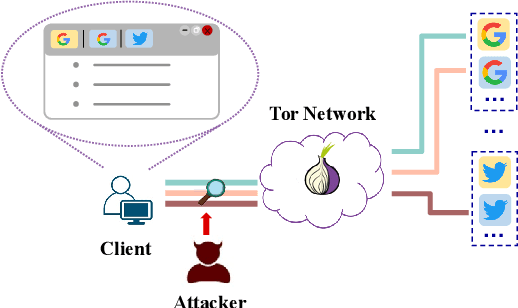
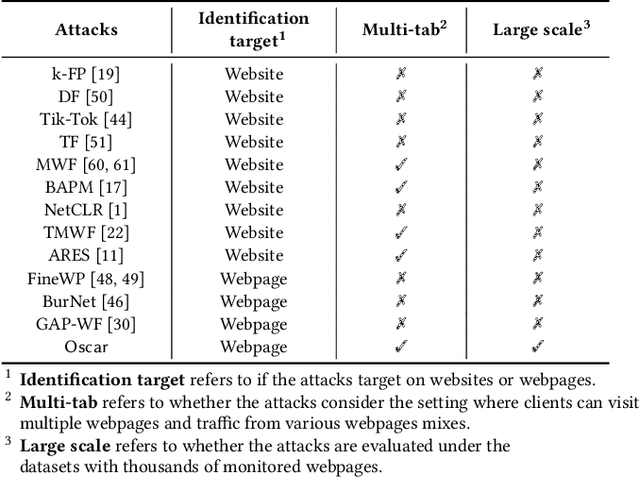
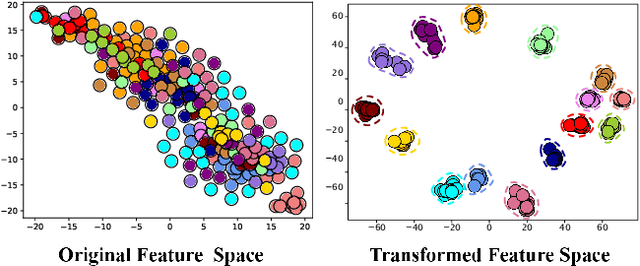

Abstract:Website Fingerprinting (WF) attacks can effectively identify the websites visited by Tor clients via analyzing encrypted traffic patterns. Existing attacks focus on identifying different websites, but their accuracy dramatically decreases when applied to identify fine-grained webpages, especially when distinguishing among different subpages of the same website. WebPage Fingerprinting (WPF) attacks face the challenges of highly similar traffic patterns and a much larger scale of webpages. Furthermore, clients often visit multiple webpages concurrently, increasing the difficulty of extracting the traffic patterns of each webpage from the obfuscated traffic. In this paper, we propose Oscar, a WPF attack based on multi-label metric learning that identifies different webpages from obfuscated traffic by transforming the feature space. Oscar can extract the subtle differences among various webpages, even those with similar traffic patterns. In particular, Oscar combines proxy-based and sample-based metric learning losses to extract webpage features from obfuscated traffic and identify multiple webpages. We prototype Oscar and evaluate its performance using traffic collected from 1,000 monitored webpages and over 9,000 unmonitored webpages in the real world. Oscar demonstrates an 88.6% improvement in the multi-label metric Recall@5 compared to the state-of-the-art attacks.
Refined Infrared Small Target Detection Scheme with Single-Point Supervision
Aug 05, 2024Abstract:Recently, infrared small target detection with single-point supervision has attracted extensive attention. However, the detection accuracy of existing methods has difficulty meeting actual needs. Therefore, we propose an innovative refined infrared small target detection scheme with single-point supervision, which has excellent segmentation accuracy and detection rate. Specifically, we introduce label evolution with single point supervision (LESPS) framework and explore the performance of various excellent infrared small target detection networks based on this framework. Meanwhile, to improve the comprehensive performance, we construct a complete post-processing strategy. On the one hand, to improve the segmentation accuracy, we use a combination of test-time augmentation (TTA) and conditional random field (CRF) for post-processing. On the other hand, to improve the detection rate, we introduce an adjustable sensitivity (AS) strategy for post-processing, which fully considers the advantages of multiple detection results and reasonably adds some areas with low confidence to the fine segmentation image in the form of centroid points. In addition, to further improve the performance and explore the characteristics of this task, on the one hand, we construct and find that a multi-stage loss is helpful for fine-grained detection. On the other hand, we find that a reasonable sliding window cropping strategy for test samples has better performance for actual multi-size samples. Extensive experimental results show that the proposed scheme achieves state-of-the-art (SOTA) performance. Notably, the proposed scheme won the third place in the "ICPR 2024 Resource-Limited Infrared Small Target Detection Challenge Track 1: Weakly Supervised Infrared Small Target Detection".
LR-Net: A Lightweight and Robust Network for Infrared Small Target Detection
Aug 05, 2024



Abstract:Limited by equipment limitations and the lack of target intrinsic features, existing infrared small target detection methods have difficulty meeting actual comprehensive performance requirements. Therefore, we propose an innovative lightweight and robust network (LR-Net), which abandons the complex structure and achieves an effective balance between detection accuracy and resource consumption. Specifically, to ensure the lightweight and robustness, on the one hand, we construct a lightweight feature extraction attention (LFEA) module, which can fully extract target features and strengthen information interaction across channels. On the other hand, we construct a simple refined feature transfer (RFT) module. Compared with direct cross-layer connections, the RFT module can improve the network's feature refinement extraction capability with little resource consumption. Meanwhile, to solve the problem of small target loss in high-level feature maps, on the one hand, we propose a low-level feature distribution (LFD) strategy to use low-level features to supplement the information of high-level features. On the other hand, we introduce an efficient simplified bilinear interpolation attention module (SBAM) to promote the guidance constraints of low-level features on high-level features and the fusion of the two. In addition, We abandon the traditional resizing method and adopt a new training and inference cropping strategy, which is more robust to datasets with multi-scale samples. Extensive experimental results show that our LR-Net achieves state-of-the-art (SOTA) performance. Notably, on the basis of the proposed LR-Net, we achieve 3rd place in the "ICPR 2024 Resource-Limited Infrared Small Target Detection Challenge Track 2: Lightweight Infrared Small Target Detection".
 Add to Chrome
Add to Chrome Add to Firefox
Add to Firefox Add to Edge
Add to Edge